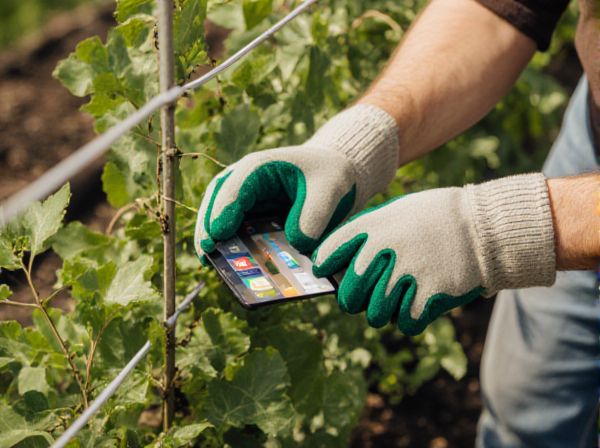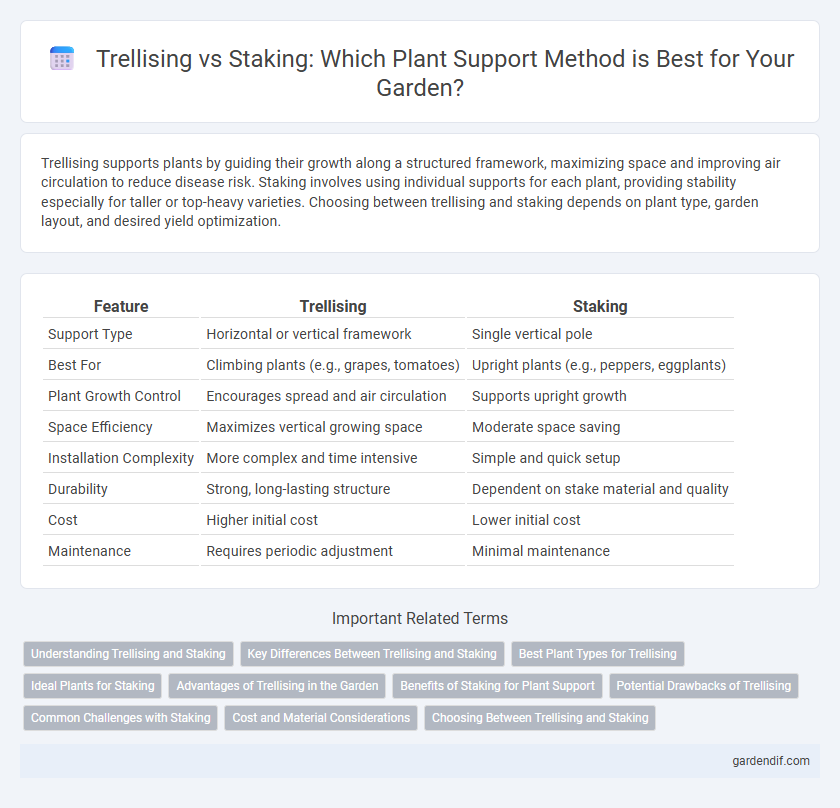
Trellising vs Staking Illustration
Trellising supports plants by guiding their growth along a structured framework, maximizing space and improving air circulation to reduce disease risk. Staking involves using individual supports for each plant, providing stability especially for taller or top-heavy varieties. Choosing between trellising and staking depends on plant type, garden layout, and desired yield optimization.
Table of Comparison
| Feature | Trellising | Staking |
|---|---|---|
| Support Type | Horizontal or vertical framework | Single vertical pole |
| Best For | Climbing plants (e.g., grapes, tomatoes) | Upright plants (e.g., peppers, eggplants) |
| Plant Growth Control | Encourages spread and air circulation | Supports upright growth |
| Space Efficiency | Maximizes vertical growing space | Moderate space saving |
| Installation Complexity | More complex and time intensive | Simple and quick setup |
| Durability | Strong, long-lasting structure | Dependent on stake material and quality |
| Cost | Higher initial cost | Lower initial cost |
| Maintenance | Requires periodic adjustment | Minimal maintenance |
Understanding Trellising and Staking
Trellising involves supporting plants with a framework of poles, wires, or lattice, enabling vertical growth and improving air circulation for healthier foliage. Staking supports individual plants using single stakes driven into the ground, ideal for preventing bending or breaking in taller, single-stemmed plants. Both methods optimize plant structure, reduce disease risk, and enhance sun exposure, but trellising suits vine-like plants, whereas staking is preferred for upright growth.
Key Differences Between Trellising and Staking
Trellising involves supporting plants with a framework of horizontal or vertical structures, ideal for vine crops like tomatoes and cucumbers to maximize space and air circulation. Staking uses individual poles or stakes to prop up single plants, providing stability primarily to taller or bushier species such as peppers or beans. Trellising supports multiple plants within a system, while staking focuses on isolated plant support, each method influencing plant growth patterns and yield efficiency.
Best Plant Types for Trellising
Vining plants such as tomatoes, cucumbers, and beans are ideal candidates for trellising due to their climbing growth habits and need for vertical support. Grapevines and passionfruit also thrive when trained on trellises, promoting better air circulation and sun exposure that enhance fruit development. Plants with flexible stems and tendrils benefit most from trellis structures, which prevent ground contact and reduce disease risks.
Ideal Plants for Staking
Ideal plants for staking include tall, upright varieties such as tomatoes, delphiniums, and peonies that require support to prevent bending or breaking. Plants with heavy flower heads or fruit clusters benefit from staking to maintain stability and promote healthy growth. Staking is especially effective for plants with relatively thin stems that cannot support their own weight in windy or crowded garden conditions.
Advantages of Trellising in the Garden
Trellising maximizes vertical growing space, enhancing air circulation around plants to reduce fungal diseases and improve overall plant health. It facilitates easier harvesting and maintenance by keeping fruits and foliage off the ground, minimizing pest infestations and soil-borne rot. Strong trellis structures support heavy crops like tomatoes, cucumbers, and beans, promoting higher yields and more efficient garden management.
Benefits of Staking for Plant Support
Staking provides essential vertical support, preventing plants from bending or breaking under the weight of fruit or foliage. This method enhances air circulation around the plant, reducing the risk of fungal diseases and promoting healthier growth. Staked plants also experience better exposure to sunlight, which improves photosynthesis and overall yield.
Potential Drawbacks of Trellising
Trellising can lead to limited airflow around plants, increasing the risk of fungal diseases and pest infestations. The installation and maintenance of trellis systems often require more time and labor compared to staking, potentially raising cultivation costs. Additionally, trellises may not support all plant types effectively, causing stress or damage to more delicate stems during growth.
Common Challenges with Staking
Staking often presents challenges such as limited plant support leading to instability during strong winds or heavy rainfall, which can cause stem damage or breakage. The manual process of tying plants to stakes can restrict natural growth patterns and increase labor demands for maintenance throughout the growing season. Unlike trellising, staking may also result in inadequate air circulation around the plant, raising the risk of fungal diseases and pest infestations.
Cost and Material Considerations
Trellising typically requires more materials such as wood, metal, or plastic frameworks, leading to higher initial costs compared to staking, which mainly uses stakes or poles. Wood trellises offer durability but increase expenses, while metal options provide long-term use at a premium price. Staking is more budget-friendly and involves minimal materials, but may need frequent replacement depending on stake quality and plant growth.
Choosing Between Trellising and Staking
Choosing between trellising and staking depends on the plant species, growth habit, and available space. Trellising provides vertical support ideal for climbing plants like tomatoes or cucumbers, enhancing air circulation and sun exposure. Staking suits plants with single stems such as peppers or eggplants, offering straightforward support to prevent bending or breakage.
Trellising vs Staking Infographic

 gardendif.com
gardendif.com